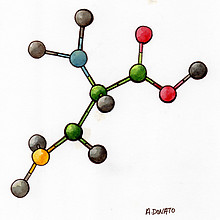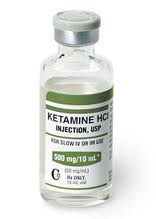Drugs that Antagonize the Glutamate NMDA Receptor are a New Approach to Antidepressant Treatment
 Several antidepressant drugs work by blocking activity at the NMDA receptor for the excitatory neurotransmitter glutamate. These drugs include intravenous ketamine, a potent NMDA receptor blocker that can produce antidepressant effects within 2 hours of administration, and memantine (Namenda), which is less potent, acts more slowly, and can potentiate the antidepressant effects of lamotrigine and help stabilize mood in patients with treatment-resistant bipolar disorder. Now a drug with a related mechanism, D-cycloserine, has been shown to have antidepressant effects. High doses of the drug act as an antagonist at the glycine site of the NMDA receptor, blocking glycine’s ability to facilitate glutamate transmission through the receptor.
Several antidepressant drugs work by blocking activity at the NMDA receptor for the excitatory neurotransmitter glutamate. These drugs include intravenous ketamine, a potent NMDA receptor blocker that can produce antidepressant effects within 2 hours of administration, and memantine (Namenda), which is less potent, acts more slowly, and can potentiate the antidepressant effects of lamotrigine and help stabilize mood in patients with treatment-resistant bipolar disorder. Now a drug with a related mechanism, D-cycloserine, has been shown to have antidepressant effects. High doses of the drug act as an antagonist at the glycine site of the NMDA receptor, blocking glycine’s ability to facilitate glutamate transmission through the receptor.
Glutamate is the major excitatory neurotransmitter in the brain and is important for the development of long-term memory. However, glutamate overactivity may contribute to depression. Decreasing this overactivity with the drugs noted above appears to produce antidepressant effects.
Uriel Heresco-Levy et al. reported in a 2013 article in the Journal of Neuropsychopharmacology that high doses of D-cycloserine (1000mg/day) had substantially greater antidepressant effects than placebo in a study of 26 patients with treatment-resistant depression. The drug was well tolerated.
Interestingly, low doses of the same drug have a different effect, acting as a partial agonist at the same site, facilitating glutamate transmission and enhancing the new learning that is necessary in cognitive behavioral therapy for anxiety disorders.
Editor’s Note: D-cycloserine requires further study in larger controlled trials, but this small study suggests promise. While ketamine’s effects are rapid in onset, they are also difficult to sustain. This study suggests a possible route to a slower onset with longer-lasting antidepressant effects.
Clarifying the Mechanism of Action of N-Acetylcysteine (NAC)
 N-acetylcysteine (NAC) is a drug available over-the-counter in health food stores that seems to be effective for a variety of disorders, including depression and many different habits and addictions. Preventing relapse of cocaine abuse is one of its uses. Researcher Kathryn Reissner at the Medical University of South Carolina found that NAC increases the expression of a glial glutamate transporter (GLT-1) that helps clear excessive glutamate in the nucleus accumbens, and that this mechanism is critical to preventing the reinstatement of cocaine self-administration in rodents.
N-acetylcysteine (NAC) is a drug available over-the-counter in health food stores that seems to be effective for a variety of disorders, including depression and many different habits and addictions. Preventing relapse of cocaine abuse is one of its uses. Researcher Kathryn Reissner at the Medical University of South Carolina found that NAC increases the expression of a glial glutamate transporter (GLT-1) that helps clear excessive glutamate in the nucleus accumbens, and that this mechanism is critical to preventing the reinstatement of cocaine self-administration in rodents.
As we have previously described in the BNN, NAC also decreases cued release of glutamate in the nucleus accumbens by potentiating the cystine-glutamate exchanger. This initially increases extrasynaptic glutamate, but subsequently downregulates glutamate release in the nucleus accumbens through actions at an inhibitory presynaptic metabotropic glutamate receptor.
However, the new data indicate that this action at the cystine-glutamate exchanger is not required for NAC’s effects on cocaine reinstatement, but the induction of GLT-1 is. Furthermore, another compound, propentofylline, which increases glutamate GLT-1, is also effective in suppressing cocaine reinstatement. Cocaine decreases a marker of glial activity, glial fibrillary acidic protein (GFAP), in the nucleus accumbens, suggesting that deficient glial functioning and uptake of glutamate could be another target of therapeutics in cocaine addiction.
Editor’s Note: There are also glial deficits in depressed patients, so it is conceivable that NAC’s effect on GLT-1 glutamate clearance is also involved in the antidepressant effects of NAC.
NAC Normalizes Glutamate Levels in Cocaine-Dependent People
 Glutamate is the major excitatory neurotransmitter in the brain, while GABA is the main inhibitory neurotransmitter. Too much or too little of one or the other can lead to an imbalance in neuronal communication. In a 2012 study by Schmaal et al. published in the journal Neuropsychopharmacology, cocaine-dependent patients were found to have high levels of glutamate in the dorsal anterior cingulate cortex. A single administration of N-acetylcysteine (NAC) at a dose of 2400mg lowered these levels.
Glutamate is the major excitatory neurotransmitter in the brain, while GABA is the main inhibitory neurotransmitter. Too much or too little of one or the other can lead to an imbalance in neuronal communication. In a 2012 study by Schmaal et al. published in the journal Neuropsychopharmacology, cocaine-dependent patients were found to have high levels of glutamate in the dorsal anterior cingulate cortex. A single administration of N-acetylcysteine (NAC) at a dose of 2400mg lowered these levels.
Healthy (non-addicted) participants who received the same administration of NAC did not show the same drop in glutamate levels.
The study also observed levels of impulsivity in the patients. Higher baseline levels of glutamate were associated with greater impulsivity, and both higher baseline level of glutamate and greater impulsivity were predictive of a larger drop in glutamate levels following NAC administration.
The researchers suggest that these findings may eventually be used in the treatment of cocaine-addicted people, since abnormal glutamate levels are related to risk of relapse. In drug-dependent rodents, NAC was found to normalize hyper-responsive glutamate release in the nucleus accumbens (the brain’s reward center) and prevent cocaine-reinstatement or relapse.
Editor’s Note: When these data from the lab of Peter Kalivas at the Medical University of South Carolina were initially collected, it was thought that NAC’s effect on a cystine-glutamate exchanger in the nucleus accumbens explained its treatment success, but new data suggest that NAC may actually facilitate glutamate clearance by increasing the number of glutamate transporters in glial cells.
Developing Rapid Onset Antidepressant Drugs That Act at the NMDA Receptor
 For several years, researchers have been exploring potential rapid-acting treatments for unipolar and bipolar depression. Intravenous ketamine has the best-replicated results so far. A slow infusion of ketamine (0.5mg/kg over 40 minutes) produces a rapid onset of antidepressant effects in only a few hours, but the improved mood lasts only 3-5 days.
For several years, researchers have been exploring potential rapid-acting treatments for unipolar and bipolar depression. Intravenous ketamine has the best-replicated results so far. A slow infusion of ketamine (0.5mg/kg over 40 minutes) produces a rapid onset of antidepressant effects in only a few hours, but the improved mood lasts only 3-5 days.
Ketamine blocks the receptors of the main excitatory neurotransmitter in the central nervous system, glutamate. Glutamate is released from nerve endings and travels across the synapse to receptors on the next cell’s dendrites. There are multiple types of glutamate receptors at the dendrites, and ketamine blocks one called the NMDA receptor, which allows calcium ions to enter the cell.
Some downsides to ketamine are the brief duration of its effectiveness and its dissociative side effects. The search is on for other drugs that are free from these side effects and that could extend the duration of rapid-onset antidepressant effects.
At the 2012 meeting of the International Congress of Neuropsychopharmacology (CINP), Mike Quirk of the pharmaceutical company AstraZeneca reviewed data on the intricacies of the glutamate NMDA receptor blockade and discussed the potential of AZD6765, an NMDA receptor blocker he and his colleagues have been researching.
The more the NMDA receptor is blocked, the more psychomimetic it becomes, meaning it produces hallucinations and delusions. For example, phencyclidine (PCP or angel dust) is a potent NMDA receptor blocker and psychosis inducer. For antidepressant purposes, a less complete or less persistent NMDA receptor blockade is desired. Read more
Anti-Alzheimer’s Drug Memantine (Namenda) Has Positive Effects On Cognitive Dysfunction In Patients With Bipolar Disorder
 Many patients with bipolar disorder experience cognitive dysfunction, but few treatments are available for this aspect of the illness. In an abstract presented at the 67th Annual Meeting of the Society of Biological Psychiatry in 2012, Dan V. Iosifescu reported that in a randomized 12-week study in which the anti-Alzheimer’s drug memantine was given to 72 euthymic bipolar subjects experiencing cognitive deficits, the drug was associated with improvement in spatial and working memory, verbal and episodic memory, and other indices that included measurements of attention and language skills. In conjunction with this treatment, a subgroup of subjects had increases in left hippocampal NAA (a measure of neuronal viability) and increases in choline in the right hippocampus. The initial improvements in these neuropsychological test results remained over 12 weeks of open follow-up.
Many patients with bipolar disorder experience cognitive dysfunction, but few treatments are available for this aspect of the illness. In an abstract presented at the 67th Annual Meeting of the Society of Biological Psychiatry in 2012, Dan V. Iosifescu reported that in a randomized 12-week study in which the anti-Alzheimer’s drug memantine was given to 72 euthymic bipolar subjects experiencing cognitive deficits, the drug was associated with improvement in spatial and working memory, verbal and episodic memory, and other indices that included measurements of attention and language skills. In conjunction with this treatment, a subgroup of subjects had increases in left hippocampal NAA (a measure of neuronal viability) and increases in choline in the right hippocampus. The initial improvements in these neuropsychological test results remained over 12 weeks of open follow-up.
Editor’s Note: These data are of considerable importance. Many studies indicate that the severity of the cognitive dysfunction patients experience while euthymic varies directly as a function of the number of prior episodes of mania or depression they have experienced. The degree of cognitive dysfunction in patients with bipolar disorder is also correlated with disability in social and economic functioning. Thus, the data that memantine can lead to improvement in several types of memory tests suggest that the drug could be useful in treating these deficits in some patients with bipolar disorder.
Memantine acts in part by blocking glutamate NMDA receptors and provides a different mechanism of action compared to the other drugs used to treat Alzheimer’s, which increase acetylcholine by blocking acetylcholinesterase.
Memantine has also shown promising effects in enhancing the antidepressant effects of lamotrigine, a drug that inhibits glutamate release. Thus, the similar target of action by which lamotrigine (blocking glutatmate release) and memantine (blocking glutamate receptors) operate suggest that the two drugs used in conjunction might produce additive effects in decreasing glutamate function. The current data suggest that memantine compared to placebo as an add-on to other agents in euthymic bipolar patients improves several measures of cognition as well.
New data published by Koukopoulos in the Journal of Affective Disorders in 2012 suggest that memantine (10-30mg/day) is an effective add-on treatment in severely ill patients with treatment-resistant bipolar disorder. Among those in Koukopoulos’ study, 72.5% were much or very much improved, thus there is a strong rationale for considering this drug.
Clinical Evidence May Explain the Mechanisms of Ketamine’s Rapid Acting Antidepressant Effects
At the 51st Annual Meeting of the National Institute of Mental Health’s New Clinical Drug Evaluation Unit (NCDEU) in 2011, C.G. Abdallah from SUNY Downstate Medical Center reported on a study of intravenous ketamine for treatment-resistant depression. Twelve medication-free participants aged 18-65 received 0.5mg/kg ketamine over 40 minutes. There was a rapid-onset antidepressant effect, as there has been in other studies of unipolar and bipolar depressed patients. In a subgroup of 4 patients examined with magnetic resonance spectroscopy (MRS), there were rapid increases in brain GABA followed shortly thereafter by increases in brain glutamate concentrations.
Editor’s note: The rapid increases in GABA and glutamate that occur after the administration of intravenous ketamine may help account for its therapeutic effects. Other studies have shown that brain GABA is low in depressed patients, so the rapid increase in GABA with ketamine administration could partly explain the antidepressant effects of the drug. The role of the glutamate increases remains to be further explored.
Neli and associates from Yale had reported that in animals, ketamine was able to rapidly alter synapse structure and function. In an animal model of depression, rodents are exposed to chronic and unpredictable stress and develop depressive-like behavior. The mature, mushroom-shaped spines on their dendrites (the parts of neurons that receive synapses and determine the neuron’s excitability) also lose their shape, becoming straighter and spikier like immature spines. Intravenous ketamine not only improves the animals’ behavior, but also increases the number of mushroom-shaped spines within a matter of hours, rapidly improving synaptic function. This effect of ketamine was dependent on a novel intracellular pathway involving the enzyme mTOR, which if blocked prevented the re-emergence of the mature spines.
In the brains of depressed humans studied at autopsy there is reduced neural volume in the frontal cortex, which could possibly be related to dendritic atrophy and associated changes in spine shape as it appears to be in rodents. The animal data suggest the remarkable possibility that intravenous ketamine’s rapid onset of antidepressant effects could also be associated with rapid improvement in the microanatomy of the brain.
The data on ketamine’s effects in animals and the new clinical data showing that GABA and glutamate increases occurred rapidly in depressed patients administered ketamine provide further insight into the potential mechanisms of ketamine’s effect.


